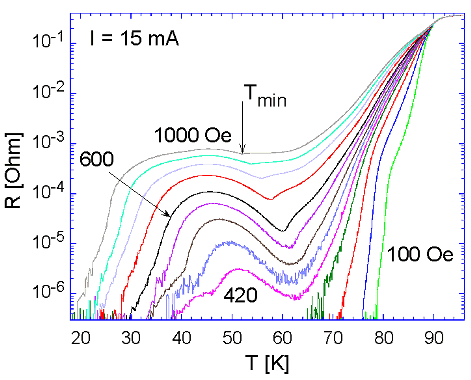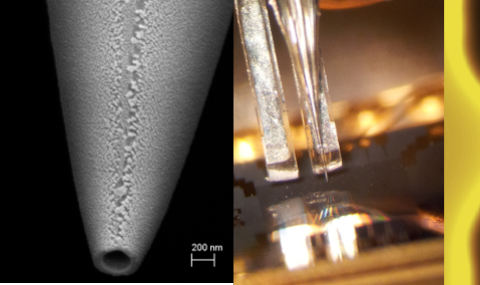Local magnetization studies in BSCCO crystals have been carried out in the presence of elevated transport currents using Hall sensors arrays, and the corresponding transport and magnetization properties were measured simultaneously. These measurements reveal an apparently paradoxical situation in which a finite resistivity is observed well below the magnetic irreversibility line. Usually, if the applied transport current is below the critical current, zero resistance should be measured and the magnetization should be hysteretic. If on the other hand the transport current is above the critical current, finite resistivity should be present with no magnetic hysteresis. Observation of a large hysteresis with simultaneous finite resistance is incompatible in principle.
The results are described in terms of a shear-induced decoupling, in which the pancake vortices flow only in the top few CuO2 planes and are decoupled from the pinned vortices in the rest of the crystal. The inhomogeneous flow of the transport current, which is injected at the top surface of the BSCCO crystals, results in a velocity gradient of the pancake vortices between the different layers and leads to the loss of the Josephson coupling. The resulting resistivity is non-monotonic with temperature and extremely non-linear. The decoupling mechanism, which is driven by the c-axis gradient of the in-plane transport current, results in a dramatic enhancement of the c-axis resistivity and the effective anisotropy.

Transport measurements of BSCCO crystals reveal an apparently paradoxical situation in which a finite resistivity is observed well below the magnetic irreversibility line. Usually, if the applied transport current is below the critical current, zero resistance should be measured and the magnetization should be hysteretic. If on the other hand the transport current is above the critical current, finite resistivity should be present with no magnetic hysteresis. Observation of a large hysteresis with simultaneous finite resistance is incompatible in principle.
Additional information
- Shear-Induced Vortex Decoupling in Bi2Sr2CaCu2O8 Crystals
B. Khaykovich, D. T. Fuchs, K. Teitelbaum, Y. Myasoedov, E. Zeldov, T. Tamegai, S. Ooi, M. Konczykowski, R. A. Doyle, and S.F.W.R. Rycroft
Phys. Rev. B 61, pp. R9261-R9264 (2000).


